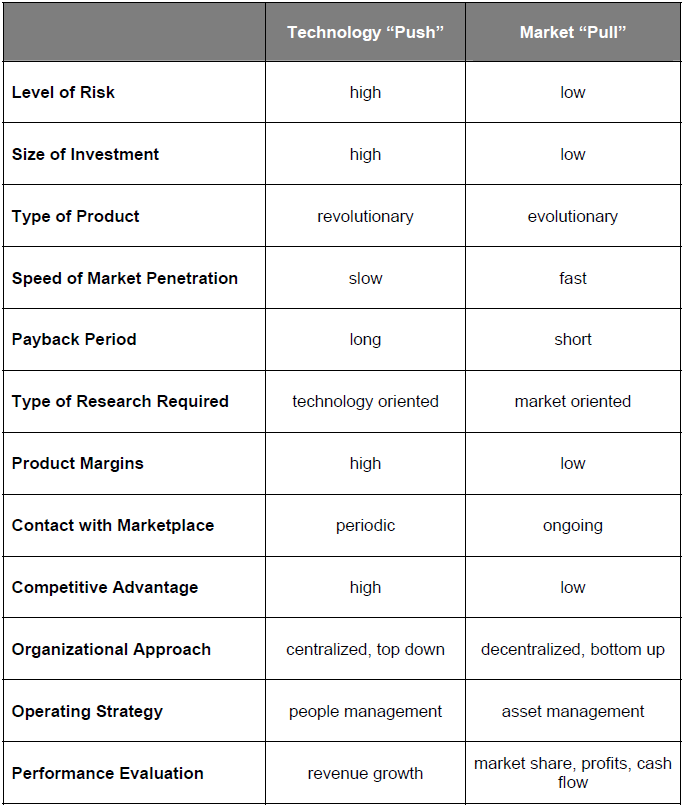This tool provides a valuable checklist of specific ideas to make sure your company is organized for innovation. It lists specific strategies for creating an environment in which innovation flourishes. Among other things, it details the pros and cons of technological “push” versus market “pull.” It also describes the role of corporate headquarters in fostering innovation.
Introduction
Innovation – some definitions:
- There is a difference between “product” and “process” innovation.
- Product innovation categories:
– market creating innovations
– performance extending innovations
– technological reorganization
– product reformulation
– product surface changes (i.e., design, packaging, branding)
- Process innovation includes just two types:
– functional re-engineering
– strategic re-engineering
Successful innovation is most often based on market demand (the 7-10 rule): The “7-10 rule” states that historically seven out of ten successful innovations were driven by a recognizable customer need – rather than a new concept, technique or technology seeking a need.
Suggested strategies
Get close to your markets:
Delegate the vast majority of both product and process innovation to individual divisions and departments.
- Get close to the customer to determine market “pull”
- Encourage innovation to be “need oriented” and, therefore, market driven
- Allow for different customer needs on a product line by product line basis
- Match-up with your basic strengths
- Other key factors for successful innovation:
– “dedicated fanatics”
– entrepreneurial orientation
– continuous, fast, empirical and flexible response system – through small, self-managed teams
Implementing product innovation
Corporate responsibilities:
- Corporate to be responsible primarily for new processes (i.e. strategic re-engineering across functional borders):
– Objective: create processes that will “exceed customer expectations”
– Types of projects: Customer databases, customer/supplier networks, new forms of distribution, etc.
– Organizational approach: small, cross-functional teams at corporate level staffed with corporate staff, delegates from individual companies and customer representatives
- Product innovation resulting from “technology push” should be coordinated and managed at corporate level (see “Product Characteristics,” page 4)
- Corporate should also take care of the following:
– mega projects, if justified
– cross disciplinary/cross company projects
– projects too specialized/too large for individual companies or divisions
Division responsibilities:
Divisions should be responsible primarily for improving/enhancing existing processes (i.e. “functional re-engineering”):
- Typical objectives: Increase speed, flexibility or quality/productivity of process
- Types of projects: Faster cycle time, improved internal communications, development, etc.
- Organizational approach: Small teams at company level with subsequent corporate meeting to exchange team findings and conclusions
Action steps to organize for innovation
Create a long-term strategy:
- Conduct “scenario” planning/assess areas of opportunity
- Establish product performance standards and objectives for innovation
- Link bonus system to innovation
- Form liaisons with possible joint venture partners
- License new technology
- Manage an internal venture capital fund
- Chair inter-division innovation steering committee
Conduct regular research:
- Track key competitors
- Identify applicable innovations at mentor companies
- Conduct focus groups of your products, others’ products
- Track trends in all relevant niches
- Monitor trade shows, journals, lectures, etc.
Improve new product development:
- Standardize submission processes
- Increase production knowledge, competencies
- Continuously measure and improve production processes
Implement training programs:
- Hold regular training, particularly in creative thinking
- Establish innovation workshops
- Provide tools/techniques for “customer need” research, how to run focus groups, etc.
- Implement staff rotation program/encourage growth of multi-taskers
- Publish innovations in corporate/division newsletters
- Hold in-house innovation fairs
Encourage joint ventures/strategic alliances:
- Monitor internal division needs for and external opportunities in joint ventures
- Co-ordinate establishment of such joint ventures
Caveats:
- Recognize and celebrate small accomplishments as they occur
- Try to “hit singles, not homeruns”
Typical issues to be resolved:
- How should we organize for innovation at the division level: in separate, parallel teams or using an integrated approach? (Tip: First try integrated approach unless it encounters apathy and resistance.)
- Where can we obtain funding for innovation? (Tip: Primary source should be from within the division via re-allocation of assets.)
- How do we stimulate creative, innovative thinking at the R&D level? (Tip: Corporate should create the “environment,” provide tools/techniques; but it’s up to division heads for leadership.)
- How do we best organize the division of corporate responsibilities? (Tip: Assign people based on a variety of decision-making styles.)
- What is the role of corporate venture fund: How much in fund, how are dollars distributed? (Tip: Establish clear criteria before any dollars are distributed.)
- What is role and membership of innovation steering committee? (Tip: Make sure chair is senior-level. Reward people for innovation by placing them on committee. Rotate people on and off steering committee at regular intervals.)
Product Characteristics: Technological “Push” Versus Market “Pull”

Interested in saving this content? Download it here.